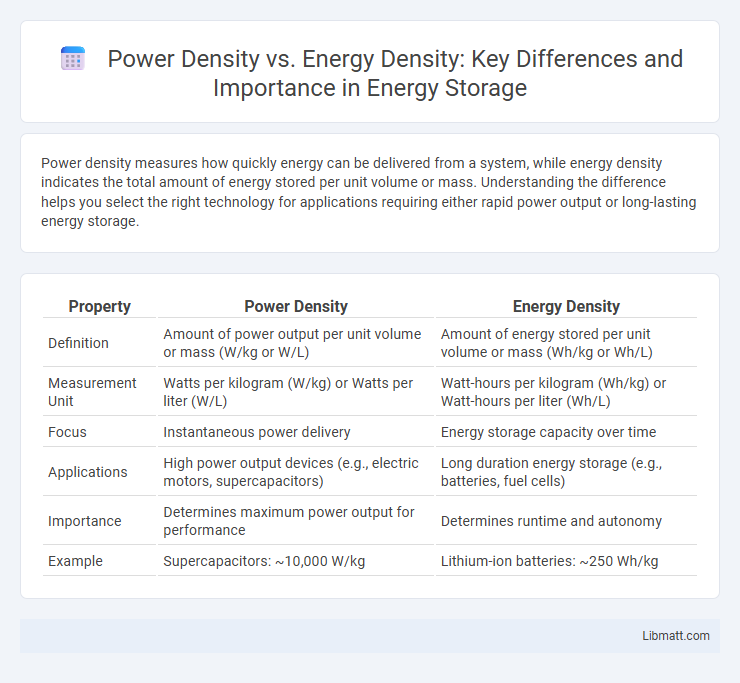Power density measures how quickly energy can be delivered from a system, while energy density indicates the total amount of energy stored per unit volume or mass. Understanding the difference helps you select the right technology for applications requiring either rapid power output or long-lasting energy storage.
Table of Comparison
| Property | Power Density | Energy Density |
|---|---|---|
| Definition | Amount of power output per unit volume or mass (W/kg or W/L) | Amount of energy stored per unit volume or mass (Wh/kg or Wh/L) |
| Measurement Unit | Watts per kilogram (W/kg) or Watts per liter (W/L) | Watt-hours per kilogram (Wh/kg) or Watt-hours per liter (Wh/L) |
| Focus | Instantaneous power delivery | Energy storage capacity over time |
| Applications | High power output devices (e.g., electric motors, supercapacitors) | Long duration energy storage (e.g., batteries, fuel cells) |
| Importance | Determines maximum power output for performance | Determines runtime and autonomy |
| Example | Supercapacitors: ~10,000 W/kg | Lithium-ion batteries: ~250 Wh/kg |
Understanding Power Density and Energy Density
Power density refers to the amount of power output a system can deliver per unit volume or mass, crucial for applications requiring rapid bursts of energy. Energy density measures the total amount of energy stored in a system per unit volume or mass, essential for long-lasting performance in batteries or fuel cells. Your choice between power density and energy density depends on whether you need quick energy delivery or sustained energy storage.
Key Differences Between Power Density and Energy Density
Power density measures the rate at which energy can be delivered per unit volume or mass, essential for applications requiring quick bursts of power like electric vehicles during acceleration. Energy density quantifies the total amount of energy stored per unit volume or mass, crucial for long-lasting energy supply in devices such as batteries and fuel cells. The key difference lies in power density's emphasis on speed of energy delivery, while energy density focuses on the total energy storage capacity.
Importance in Battery Technology
Power density and energy density are critical parameters in battery technology, determining performance and application suitability. High power density enables rapid energy delivery for devices requiring quick bursts of power, such as power tools or electric vehicles during acceleration. Your choice between batteries with higher energy density, ideal for longer-lasting energy storage, and those with high power density should align with specific usage needs, balancing runtime and power output efficiently.
Applications in Electric Vehicles
Power density determines how quickly an electric vehicle (EV) battery can deliver energy for acceleration and regenerative braking, while energy density influences the total driving range by defining how much energy the battery stores. High power density batteries are essential for performance EVs requiring rapid bursts of energy, whereas high energy density batteries enable longer trips without frequent charging. Your EV's efficiency and usability depend on balancing these densities to meet both power demands and driving distance.
Impacts on Renewable Energy Storage
Power density and energy density critically influence renewable energy storage solutions by determining the efficiency and duration of power delivery. High power density enables rapid energy discharge, which is essential for grid stability during peak demand, while high energy density supports long-term energy retention, crucial for intermittent sources like solar and wind. Balancing these properties in technologies such as batteries, supercapacitors, and fuel cells optimizes storage systems for scalability, cost-effectiveness, and sustainability in renewable energy integration.
Relevance in Portable Electronics
Power density and energy density play crucial roles in portable electronics, with power density determining how quickly a device can deliver energy for high-performance tasks, while energy density influences the overall runtime between charges. High power density is vital for devices requiring rapid bursts of energy, such as smartphones during intensive processing, whereas high energy density extends battery life, minimizing the need for frequent recharging. Understanding these densities allows you to select or design batteries that balance performance and longevity for optimal portable device functionality.
Technological Innovations Affecting Densities
Advancements in battery technology, such as solid-state electrolytes and nanostructured electrodes, significantly enhance power density by enabling faster charge and discharge rates without compromising energy storage capacity. Innovations in materials like lithium-silicon anodes and lithium-sulfur cathodes improve energy density by increasing the amount of energy stored per unit weight or volume. These technological breakthroughs collectively push the boundaries of energy storage systems, optimizing performance for electric vehicles and portable electronics.
Material Choices and Their Influence
Material choices significantly influence both power density and energy density in energy storage systems. High power density materials, such as graphene and carbon nanotubes, enable rapid charge and discharge rates by facilitating fast electron and ion transport. Conversely, materials like lithium cobalt oxide or lithium iron phosphate offer higher energy density due to their ability to store more electrical energy per unit weight, though often at the expense of power output.
Power vs. Energy Density: Choosing the Right Solution
Power density measures how quickly energy can be delivered, critical for applications needing rapid bursts of power, while energy density indicates the total energy stored per unit volume or mass, key for long-lasting performance. Your choice depends on whether the priority is high power output, like in electric vehicles accelerating, or sustained energy supply, such as in portable electronics. Understanding the trade-off between power density and energy density ensures optimal selection for specific energy storage solutions.
Future Trends in Density Optimization
Future trends in density optimization emphasize balancing power density and energy density to enhance battery performance for electric vehicles and renewable energy storage. Advanced materials like solid-state electrolytes and nanostructured electrodes are being developed to increase both energy capacity and charge-discharge rates simultaneously. Integration of machine learning in battery design accelerates discovery of optimal chemistries, promising significant improvements in density metrics over the next decade.
Power Density vs Energy Density Infographic

 libmatt.com
libmatt.com